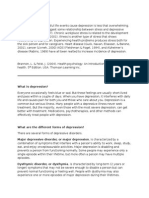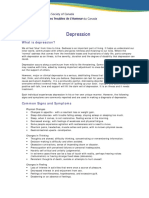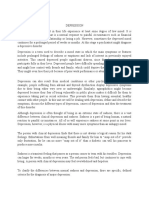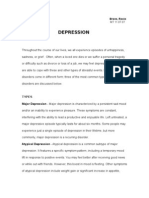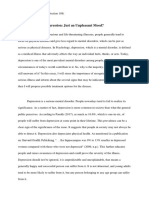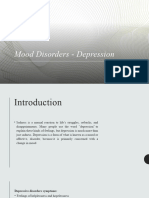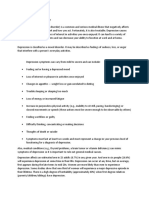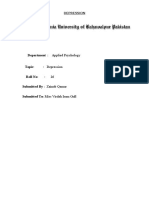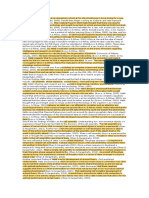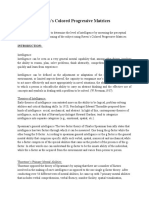0% found this document useful (0 votes)
63 views16 pagesUnderstanding Depression Basics
Depression is a common and serious medical illness that negatively impacts mood, thinking, and behavior. It causes feelings of sadness and loss of interest in activities. Symptoms can range from mild to severe and include changes in appetite, sleep, energy levels, concentration, and thoughts of death or suicide. To be diagnosed with depression, symptoms must last at least two weeks and represent a change from the person's normal functioning. Major depression, persistent depressive disorder, bipolar disorder, and seasonal affective disorder are the most common types of depression. Psychological theories focus on cognition and behavior influencing mood, while biological theories emphasize genetic and neurological factors.
Uploaded by
priyanshi khandelwalCopyright
© © All Rights Reserved
We take content rights seriously. If you suspect this is your content, claim it here.
Available Formats
Download as DOCX, PDF, TXT or read online on Scribd
0% found this document useful (0 votes)
63 views16 pagesUnderstanding Depression Basics
Depression is a common and serious medical illness that negatively impacts mood, thinking, and behavior. It causes feelings of sadness and loss of interest in activities. Symptoms can range from mild to severe and include changes in appetite, sleep, energy levels, concentration, and thoughts of death or suicide. To be diagnosed with depression, symptoms must last at least two weeks and represent a change from the person's normal functioning. Major depression, persistent depressive disorder, bipolar disorder, and seasonal affective disorder are the most common types of depression. Psychological theories focus on cognition and behavior influencing mood, while biological theories emphasize genetic and neurological factors.
Uploaded by
priyanshi khandelwalCopyright
© © All Rights Reserved
We take content rights seriously. If you suspect this is your content, claim it here.
Available Formats
Download as DOCX, PDF, TXT or read online on Scribd
/ 16
